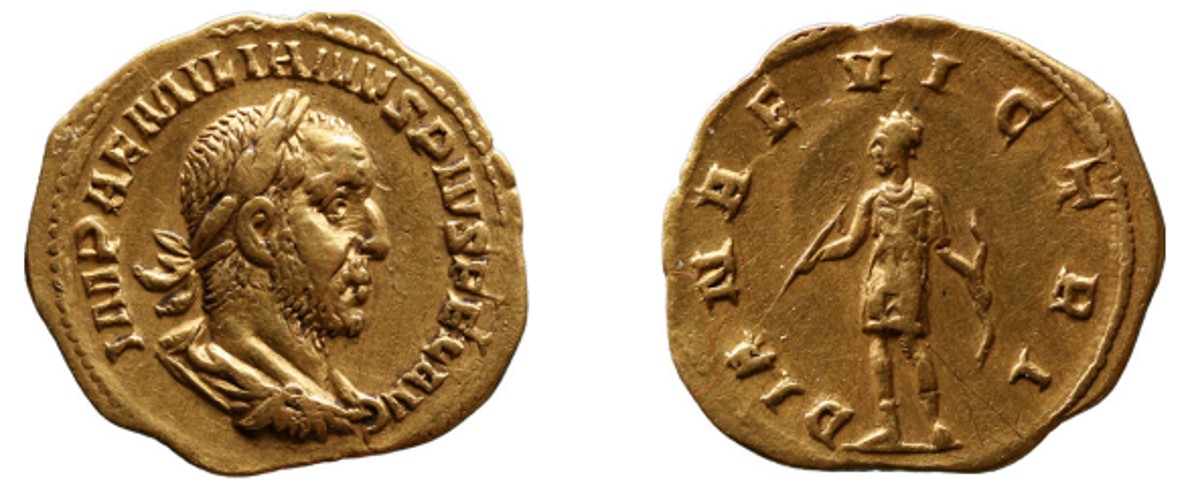Rome (Aemilian), gold, aurei (Aemilianus/standing Diana) (253 CE)
From SILVER
(Redirected from Rome (Aemilian), gold, aurei (253 CE))
253 CE - 253 CE Gold 2,340 kg
Description
| ObverseInscription or printing placed on the obverse.: | IMP AEMILIANVS PIVS FEL AVG (Latin).Cuirassed and draped bust to right, with laurel wreath |
| ReverseInscription or printing placed on the reverse.: | DIANAE VICTRI (Latin).Diana standing, almost facing but her head to the left, a bow in her left hand, an arrow in the right |
Mint and issuing power
| MintIdentifies the place of manufacture or issue of a numismatic object.: | Rome | Ancient regionAncient region.: | Latium | Modern countryModern country: Italy | AuthorityIdentifies the issuing power. The authority can be "pretended" when the name or the portrait of X is on the coin but he/she was not the issuing power. It can also be "uncertain" when there is no mention of X on the coin but he/she was the issuing power according to the historical sources: | Aemilian (253 CE), Roman Empire |
Chronology
| FromIdentifies the initial date in a range assigned in a numismatic context. | 253 CE | toIdentifies the final date in a range assigned in a numismatic context.. | 253 CE | PeriodTime period of the numismatic object.: Roman from 30 BC |
Physical description
| MetalThe physical material (usually metal) from which an object is made.: | Gold |
Median weightMedian of the weights of numismatic objects (in grams). in grams | 3.60 | DenominationTerm indicating the value of a numismatic object. Examples: tetradrachm, chalkous, denarius.: | aureus | StandardStandard.: |
References
| Die study referencePublication of the study: | Rambach 20171Rambach 2017 | ||
| Coin series referenceReference to coin series study: | |||
Obverse dies distribution
| FrequencyFrequency of specimen in distribution. ᵖ | Number of obversesNumber of obverse dies. ᵖ (o) | % (o) | Number of coinsNumber of coins. (n) | % (n) | Die nameName(s) of the die(s). |
| 1 | 1 | 50 | 1 | 25 | 2 |
| 3 | 1 | 50 | 3 | 75 | 1 |
| Total | 2 of 2 | 100 | 4 of 4 | 100 |
Reverse dies distribution
no distribution is available
Quantification
| Number of obversesNumber of obverse dies. ᵖ (o) | 2 | Number of singletons (o1)The number of singleton coins. ᵖ | 1 |
| Number of reverse diesNumber of reverse dies. (r) | 3 | Number of coinsNumber of coins. (n) | 4 |
| Coins per obverse dieNumber of coins per obverse die. (n/o) | 2 | Coins per reverse dieNumber of coins per reverse die. (n/r) | 1.33 |
| Reverse per obverse ratioRatio of obverse dies divided by reverse dies. (r/o) | 1.5 | Percentage of singletons (o1)number of coins (n) divided by the number of singletons (o1) ᵖ | 50 % |
| Original number of dies (O) (Carter 1983 formula)The estimation of the number of coins according to Carter 1983 ᵖ | 3.25 | Coins struck if 20,000 as average productivity per dieCoins made if the average productivity for obverses (according to Carter) is 20,000. ᵖ | 65,000 |
| Original number of dies (O) (Esty 2011 formula)The estimation of the number of coins according to the singleton formula in Esty 2011 ᵖ (O) | 4 | Survival rate if 20,000 as average productivity per dieSurvival rate if average productivity is 20,000. ᵖ | 0.00006 |
| Coverage (o = % of O) (Esty 1984 formula)Esty 1984 - coverage (% of O) ᵖ (o = % of O) | 75% | Die productivity if survival rate 1/2,000Average productivity if survival rate is 1/2,000. ᵖ | 2,461.54 |
| Weight of silver (in kg) if 20,000 coins per die (O = Carter formula)Carter 1983 * Median weight * 20000 (*10 if gold or electrum) ᵖ | 2,340 kg <br /> 2,340 kg | Die productivity if survival rate 1/5,000Average productivity if survival rate is 1/5,000. ᵖ | 6,153.85 |
Remarks
Most likely one single workstation Likely military
"Expression error: Unexpected * operator." is not a number.
References
- ^ Rambach, Hadrien (2017), "Notes on the gold coinage of Aemilian," Bulletin du Cercle d’Etudes Numismatiques, 54 (3), p. 2-33.
